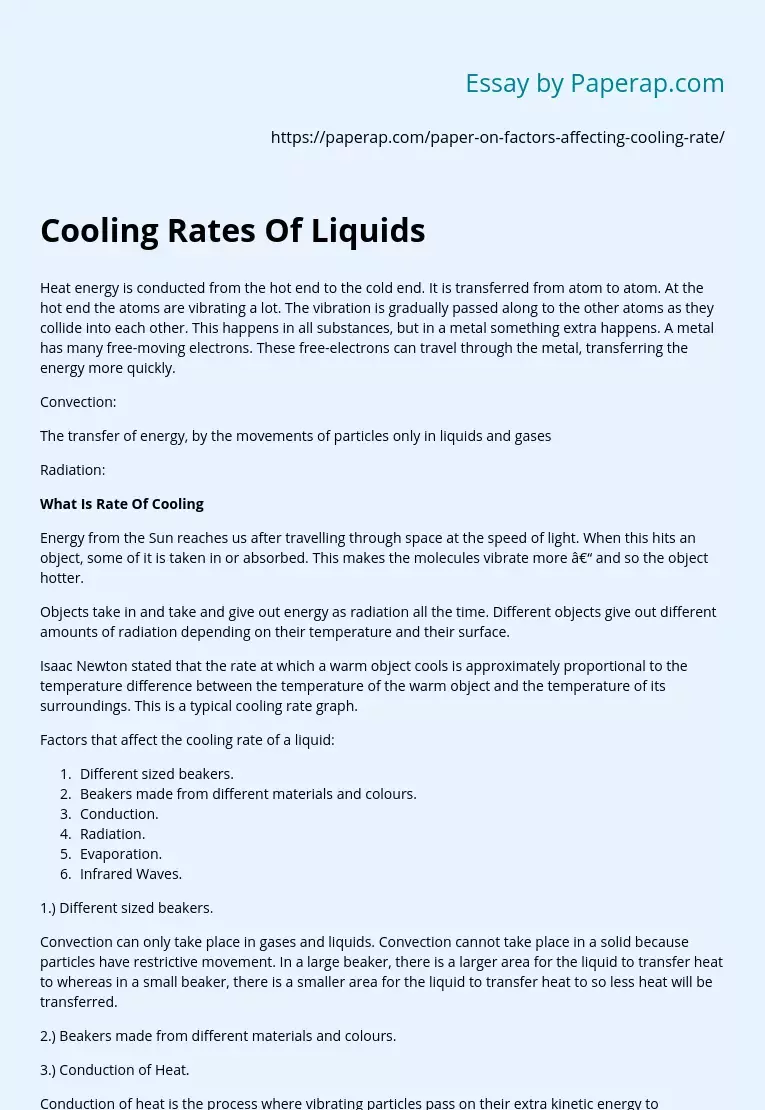Cooling Rates Of Liquids
Heat energy is conducted from the hot end to the cold end. It is transferred from atom to atom. At the hot end the atoms are vibrating a lot. The vibration is gradually passed along to the other atoms as they collide into each other. This happens in all substances, but in a metal something extra happens. A metal has many free-moving electrons. These free-electrons can travel through the metal, transferring the energy more quickly.
Convection:
The transfer of energy, by the movements of particles only in liquids and gases
Radiation:
What Is Rate Of Cooling
Energy from the Sun reaches us after travelling through space at the speed of light.
When this hits an object, some of it is taken in or absorbed. This makes the molecules vibrate more – and so the object hotter.
Objects take in and take and give out energy as radiation all the time. Different objects give out different amounts of radiation depending on their temperature and their surface.
Isaac Newton stated that the rate at which a warm object cools is approximately proportional to the temperature difference between the temperature of the warm object and the temperature of its surroundings. This is a typical cooling rate graph.
Factors that affect the cooling rate of a liquid:
- Different sized beakers.
- Beakers made from different materials and colours.
- Conduction.
- Radiation.
- Evaporation.
- Infrared Waves.
1.) Different sized beakers.
Convection can only take place in gases and liquids. Convection cannot take place in a solid because particles have restrictive movement.
In a large beaker, there is a larger area for the liquid to transfer heat to whereas in a small beaker, there is a smaller area for the liquid to transfer heat to so less heat will be transferred.
2.) Beakers made from different materials and colours.
3.) Conduction of Heat.
Conduction of heat is the process where vibrating particles pass on their extra kinetic energy to neighbouring particles.
4.) Radiation.
5.) Evaporation.
When a liquid below its boiling point changes into a gas, this is called evaporation. It happens because some particles in the liquid move faster than others. The faster ones near the surface have enough energy to escape to form a gas.
6.) Infrared.
Energy to heat us up travels from the Sun at the speed of light, jut like the light rays. The rays which cause the most heating are called infrared waves. All objects emit some infrared because of the motion of their atoms or molecules. Most radiate a wide range of wavelengths. As an object heats up, it radiates more and more infrared and shorter wavelengths.
Aim: To investigate how the surface area of a beaker affects the cooling rate of a liquid.
Prediction: I predict that the bigger the beaker, the less time it will take for the liquid to cool down. This is because gases and liquids are more liable to move around which allows them to transfer heat easily by convection. Convection cannot take place in solids because the particles have restrictive movement. In a bigger beaker, the particles have a larger area to transfer heat to whereas in a smaller beaker water particles have less area to move around in so less heat would be transferred.
We know that if anything hot is poured it will eventually cool down. This process is rapid at first, then after a long period of time, the temperature of the liquid reaches room temperature. These temperature variations for cooling objects were summarised by Isaac Newton. He stated that the rate at which a warm object cools is approximately proportional to the temperature difference between the temperature of the warm object and the temperature of its surroundings.
Fair Test:
Start temperature: Ensure that the initial temperature reading of the water is always 70�C for all experiments. This is to make sure that there is no temperature variation in the start temperature. It will be taken into account that there will be a �0.5% accuracy level of this reading.
Time: Ensure that the temperature readings are recorded as accurately as possible to sixty seconds for each experiment using a digital stopwatch.
Radiation: Heat Radiation travels through transparent material such as glass. Therefore wrap a layer of aluminium foil around the beaker.
Convection: Convection occurs when particles move from the hotter region to the cooler region. To ensure that no heat is lost due to this place an insulating material (wool) around the beaker.
Evaporation: When a liquid evaporates, faster particles escape from its surface to form a gas. However, unless the gas is removed, some of the particles will return to the liquid. Place an insulating material (wood) that fits into the top part of the beaker to reduce evaporation.
Room Temperature: While I carry out the experiment I will make sure that the room temperature is always the same using a thermometer with a 0.5% accuracy level.
Cooling Rates Of Liquids. (2019, Dec 05). Retrieved from https://paperap.com/paper-on-factors-affecting-cooling-rate/

